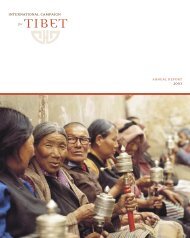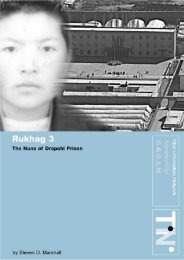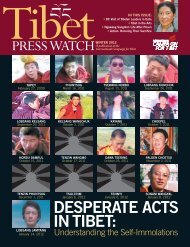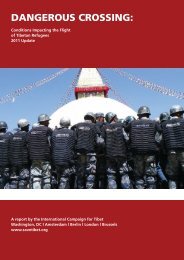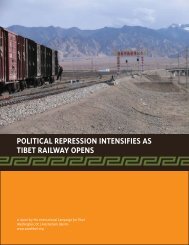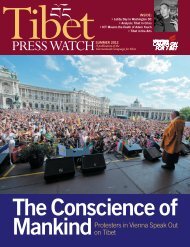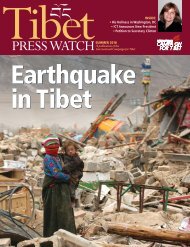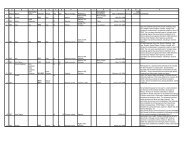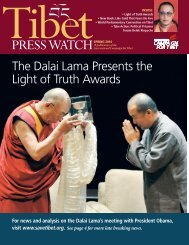download the report - International Campaign for Tibet
download the report - International Campaign for Tibet
download the report - International Campaign for Tibet
Create successful ePaper yourself
Turn your PDF publications into a flip-book with our unique Google optimized e-Paper software.
INTERNATIONAL CAMPAIGN FOR TIBET<br />
PROTESTS IN TIBET SINCE MARCH 10, 2008<br />
“I thought that this [<strong>the</strong> uprising] was <strong>the</strong> right thing to do. I participated in <strong>the</strong><br />
protests and was among <strong>the</strong> protestors in <strong>the</strong> area of Ramoche monastery [in Lhasa]<br />
<strong>for</strong> about two hours [on March 14]. I knew that <strong>the</strong> protests were expressions of <strong>Tibet</strong>an<br />
despair over Chinese oppression in our own country.”<br />
— a <strong>Tibet</strong>an participant in <strong>the</strong> March 14 protests, testimony to ICT<br />
“It could be that <strong>the</strong>y [<strong>the</strong> protestors, particularly referring to <strong>the</strong> monks] could not take<br />
oppression any more. The fact that <strong>the</strong> Chinese are <strong>for</strong>cing <strong>Tibet</strong>ans to denounce His<br />
Holiness <strong>the</strong> Dalai Lama everyday makes <strong>Tibet</strong>ans put <strong>the</strong>ir lives on <strong>the</strong> line and protest.”<br />
— a <strong>Tibet</strong>an source who witnessed a protest in Kardze on March 18,<br />
speaking to <strong>the</strong> <strong>Tibet</strong>an newspaper in exile Bod Kyi Bang Chen<br />
“I think <strong>the</strong> main issue [behind <strong>the</strong> protests] was getting China to allow <strong>the</strong> Dalai Lama<br />
to come back to <strong>Tibet</strong>, as well as human rights. [...] I think <strong>the</strong>se were defensive protests,<br />
concerning questions of national identity.”<br />
— Professor Tsering Shakya, New Left Review 51, May–June 2008.<br />
THIS NEW LIST OF PROTESTS prepared by ICT and <strong>the</strong> map showing <strong>the</strong>ir geographical<br />
distribution shows <strong>the</strong> rapidity and intensity with which unrest<br />
spread through eastern and far eastern regions of <strong>the</strong> plateau following <strong>the</strong><br />
events in Lhasa on March 10–14. These are predominantly rural areas, most of which<br />
have not seen nationalist uprisings since <strong>the</strong> 1950s, and some of which enjoy <strong>the</strong><br />
highest levels of economic development and educational opportunity of all <strong>Tibet</strong>an<br />
regions of <strong>the</strong> PRC.<br />
If it were true that <strong>the</strong> majority of rural <strong>Tibet</strong>ans are reconciled with Communist Chinese<br />
rule and prospering under recent economic policies, Kanlho <strong>Tibet</strong>an Autonomous<br />
Prefecture (Chinese: Gannan TAP) in Gansu province and eastern Qinghai,<br />
<strong>the</strong> most affluent <strong>Tibet</strong>an regions, in closest proximity to urbanising centres in mainland<br />
China, should provide <strong>the</strong> most evidence of this. Instead, <strong>the</strong>y were at <strong>the</strong> <strong>for</strong>efront<br />
of <strong>the</strong> uprising. This was not just in relatively politicised monastic centres like<br />
Labrang (Chinese: Xiahe) in Kanlho TAP and Rebkong (Chinese: Tongren) in Malho<br />
TAP in Qinghai province: March 2008 brought <strong>the</strong> names of places like Machu (Chinese:<br />
Maqu) in Kanlho TAP, Amchok Bora in Chone (Chinese: Zhuoni) in Kanlho TAP,<br />
15



